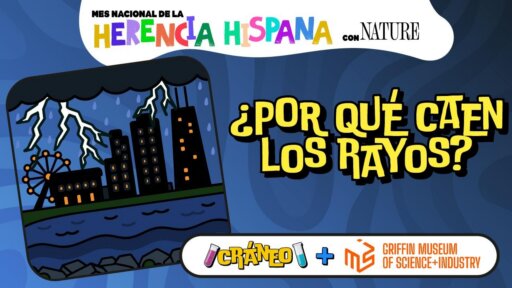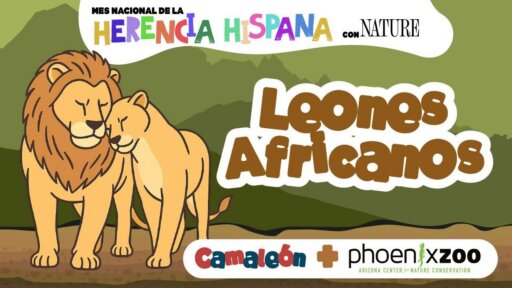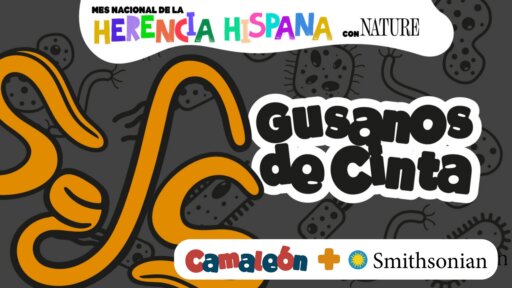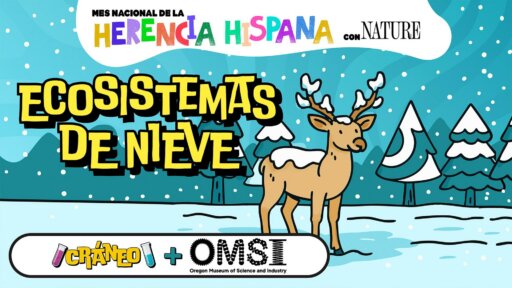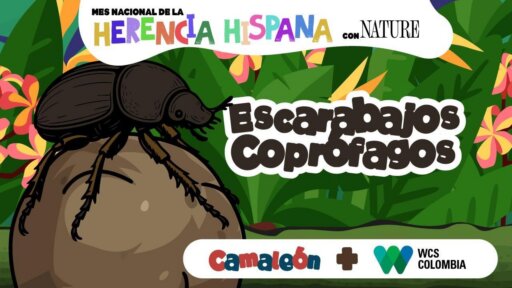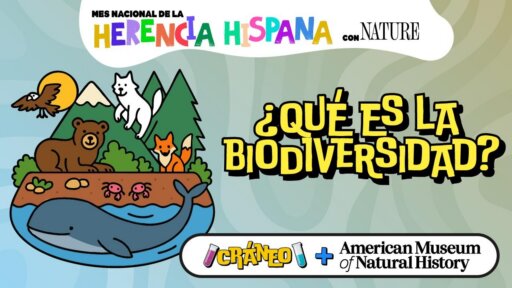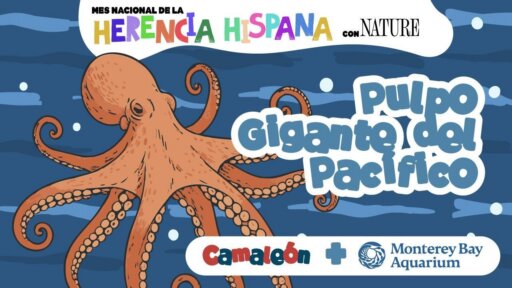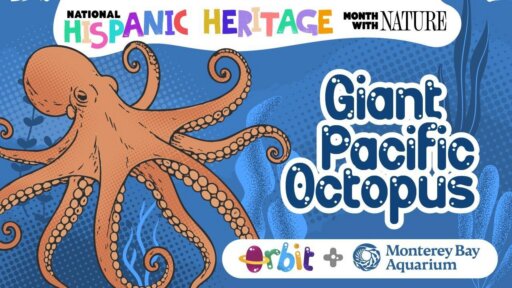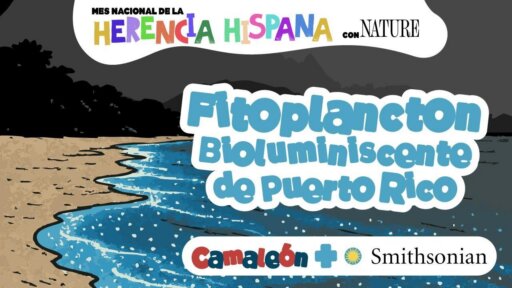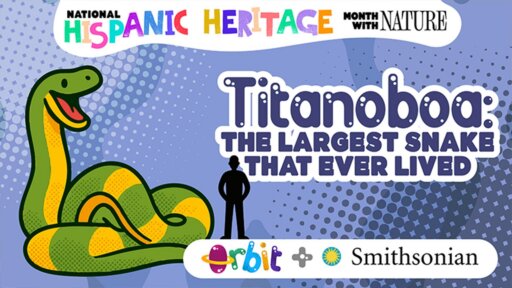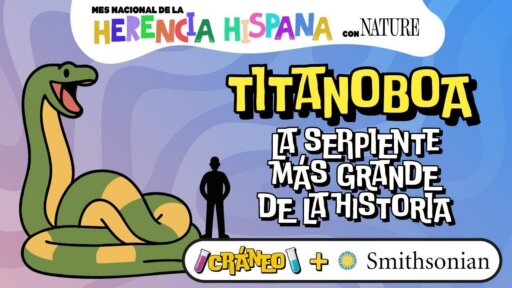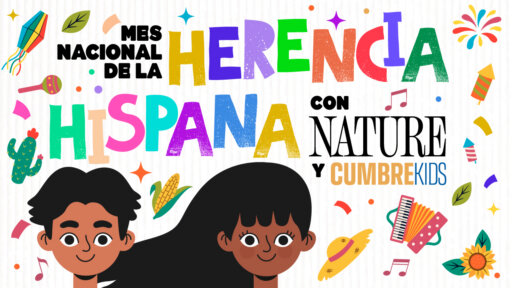TRANSCRIPT (ES)
00:00:01 Robert:
Hi there, Rob here.
00:00:03 Robert:
This episode is part of a bilingual children’s podcast series for National Hispanic Heritage Month, a collaboration between PBS Nature and Cumbre Kids.
00:00:11 Robert:
This series features scientists from leading museums, zoos, and aquariums across the United States, responding to questions submitted by listening children 3 to 10 years old.
00:00:21 Robert:
These episodes appear on the podcast’s Orbit, Science for Kids on the Move, Cranio, Ciencia Paraninos Curiosos, and Camaleone, Animalis Bada
00:00:30 Robert:
niños curiosos.
00:00:31 Robert:
They are podcasts for families with children 3 to 10 years old and can be found on YouTube, Spotify, Apple Podcasts or wherever you listen to podcasts.
00:00:39 Robert:
Just a heads up.
00:00:40 Robert:
This episode is in Spanish.
00:00:42 Robert:
We hope you enjoy.
00:00:48 Wil:
Hola, amigos cráneos.
00:00:50 Wil:
Estoy emocionado porque estoy a punto de entrar a un submarino para explorar y aprender sobre el océano.
00:00:57 Wil:
¿Me acompañan?
00:00:58 Wil:
Vamos, entremos todos juntos en el submarino.
00:01:05 Wil:
¿Están listos para sumergirse?
00:01:07 Wil:
¡Vamos! ¡Wow, qué hermoso! Miremos a través de las ventanas.
00:01:32 Wil:
¡Wow, miren! Son peces con colores muy brillantes.
00:01:38 Wil:
Miren allí, hay corales que parecen jardines.
00:01:43 Wil:
miren una tortuga nadando y por allá hay una ballena wow
00:01:55 Wil:
¿Se han preguntado alguna vez de dónde salió tanta agua?
00:01:59 Wil:
De seguro que sí, pues hoy es una excelente oportunidad para aprender sobre la inmensidad del océano.
00:02:06 Niños:
¿Por qué el océano es tan salado?
00:02:08 Niños:
¿Qué tipo de científicos estudia en el océano?
00:02:12 Niños:
¿Qué porcentaje del océano se ha explorado?
00:02:14 Wil:
Ja.
00:02:15 Wil:
Sabía que tendrían preguntas tan buenas como esas y justamente por eso encontré a una persona experta en este tema.
00:02:23 Wil:
Ella nos acompañará en este episodio para enseñarnos un montón de cosas sobre el océano.
00:02:29 Wil:
Saludemos todos juntos.
00:02:31 Wil:
¡Hola.
00:02:35 Dra. Estefanía Pihen G:
Hola a todos y a todos, mucho gusto.
00:02:38 Dra. Estefanía Pihen G:
Es un placer tener este espacio para compartir con ustedes sobre mi trabajo.
00:02:44 Dra. Estefanía Pihen G:
Yo soy la doctora Estefanía Pién González.
00:02:47 Dra. Estefanía Pihen G:
Soy la decana de educación en la Academia de Ciencias de California.
00:02:52 Dra. Estefanía Pihen G:
Estamos en San Francisco, California.
00:02:54 Dra. Estefanía Pihen G:
Mi trabajo es muy lindo y básicamente lo que yo hago es guiar a muchos equipos de educadores para que hagan programas para niños, niñas, inclusive familias y adultos.
00:03:06 Dra. Estefanía Pihen G:
para que las personas puedan aprender por qué es que somos parte del mundo natural y por tanto, por qué tenemos que cuidarlo.
00:03:15 Dra. Estefanía Pihen G:
Y lo más importante, les damos muchas opciones y conocimiento para que las personas sepan cómo pueden colaborar para proteger al mundo natural.
00:03:24 Wil:
¡Ah, mira! Precisamente eso es lo que necesitamos, que nos enseñes hoy sobre el mundo natural y para ser más precisos sobre el océano.
00:03:34 Wil:
Por cierto,
00:03:35 Wil:
¿Podrías decirnos qué significa la palabra océano?
00:03:40 Dra. Estefanía Pihen G:
La palabra océano viene de el griego o “kianos” y en griego significa una gran corriente de agua que rodea a la Tierra.
00:03:49 Wil:
¡Ajá! Tan sencillo como eso.
00:03:52 Wil:
Una gran corriente de agua que rodea a la Tierra.
00:03:55 Wil:
¡Genial! Los océanos cubren más del 70% de la superficie de la Tierra.
00:04:02 Wil:
Eso quiere decir que cuando miramos un mapa, podremos ver más agua que tierra.
00:04:08 Wil:
Nuestro planeta debería llamarse más bien planeta océano, en lugar de planeta tierra, ¿no creen?
00:04:14 Wil:
Hola.
00:04:15 Daniel:
Cráneo, soy Daniel Cabrera, tengo 5 años, vivo en Ecuador.
00:04:20 Daniel:
Y mi pregunta es, ¿por qué el océano es tan salado?
00:04:24 Daniel:
Chao.
00:04:27 Dra. Estefanía Pihen G:
Excelente pregunta, Daniel.
00:04:30 Dra. Estefanía Pihen G:
Yo me pensaba lo mismo hace mucho tiempo y le pregunté también a alguien y aprendí que hace muchísimo, muchísimo tiempo, cuando la tierra se estaba formando, lo que habían eran muchos volcanes y estos volcanes que hicieron erupción de lava.
00:04:46 Dra. Estefanía Pihen G:
La lava poco a poco se fue enfriando y se hicieron rocas, pero esas rocas eran saladas.
00:04:54 Dra. Estefanía Pihen G:
y un día por un proceso químico comenzó a llover, pero no llovió un día, llovió miles de millones de años y toda esa lluvia fue lavando las rocas y la sal que tenían las rocas y a través de estos miles de millones de años se fueron llenando todas las rocas, los espacios entre las rocas y se hicieron los océanos, pero los océanos salados por toda esa lluvia que lavó las rocas.
00:05:21 Wil:
¡Wow! sorprendente ¿verdad cráneos?
00:05:23 Wil:
Algo importante que agregar es que cuando el agua del océano se evapora con el sol, solo sube el agua al aire, pero la sal se queda.
00:05:32 Wil:
La evaporación es cuando el calor del sol hace que el agua se transforme en vapor y suba al cielo, como si se volviera un gas invisible.
00:05:42 Wil:
Es como cuando la ropa mojada se seca al sol.
00:05:46 Wil:
Entonces, aunque el agua del océano se evapora y sube al cielo, la sal siempre se queda guardada en el océano.
00:05:54 Wil:
Por eso el mar nunca deja de ser salado.
00:05:57 Wil:
De hecho, si tomáramos toda la sal del océano y la pusiéramos sobre la Tierra, habría suficiente sal para cubrir la Tierra entera.
00:06:06 Wil:
Estefanía, por ahí he escuchado algunas personas hablar de diferentes océanos.
00:06:12 Wil:
Es que hay varios océanos.
00:06:14 Wil:
¿Cuántos hay?
00:06:17 Dra. Estefanía Pihen G:
Hay cinco, tenemos el Pacífico, el Atlántico, el Ártico, el Índico y el Antártico, abajo, en el sur.
00:06:26 Wil:
Entonces, sí es cierto lo que he oído.
00:06:30 Dra. Estefanía Pihen G:
Ahora, de esos cinco océanos, como las personas, los océanos tienen sus propias características.
00:06:36 Dra. Estefanía Pihen G:
Por ejemplo, el Pacífico es más salado, es más caliente que el Atlántico y claro, más caliente que el Ártico y que el Antártico.
00:06:44 Dra. Estefanía Pihen G:
Y también hay vida marina que es diferente en cada uno de estos océanos.
00:06:49 Dra. Estefanía Pihen G:
Por ejemplo, en el Ártico tenemos a los osos polares y en el Antártico tenemos a los pingüinos, ¿verdad?
00:06:57 Dra. Estefanía Pihen G:
En el océano Pacífico tenemos a un tipo de tortuga, una especie, Natatur de presus, que es el nombre científico en latín, que el nombre común es la tortuga plana, que solo vive en el océano Pacífico, ellas solo están ahí.
00:07:13 Dra. Estefanía Pihen G:
En cambio en el Atlántico tenemos todas las especies de tortugas marinas, entonces en cada uno de los océanos encontramos diferentes tipos de vida marina, porque la salinidad, las temperaturas son diferentes.
00:07:26 Wil:
Ah ya veo, es que tenemos un gran océano dividido en cinco partes y que cada una de ellas tiene características únicas que la hacen diferentes de las demás, por eso decimos que tenemos varios océanos en nuestro planeta.
00:07:46 Eduardo:
Hola cráneo, soy Eduardo y vivo en República Dominicana, tengo 6 años y mi pregunta es, ¿hay plantas venenosas abajo del océano?
00:08:00 Nicolás:
Hola cráneo, me llamo Nicolás, tengo 8 años y vivo en Puerto Morelos, México, y quiero saber qué porcentaje del océano se ha explorado.
00:08:08 Nicolás:
Gracias.
00:08:12 Dra. Estefanía Pihen G:
Claro, Eduardo Nicolás, excelente pregunta.
00:08:16 Dra. Estefanía Pihen G:
Sí, hay plantas venenosas.
00:08:18 Dra. Estefanía Pihen G:
En realidad son algas.
00:08:20 Dra. Estefanía Pihen G:
Las algas marinas son parte de diferentes reinos.
00:08:23 Dra. Estefanía Pihen G:
Uno de esos reinos es el reino de las plantas.
00:08:26 Dra. Estefanía Pihen G:
También hay algas que son parte del reino de las bacterias.
00:08:30 Dra. Estefanía Pihen G:
Hay muchas algas que son venenosas.
00:08:33 Dra. Estefanía Pihen G:
Son venenosas porque producen un veneno, una toxina.
00:08:38 Dra. Estefanía Pihen G:
Te voy a dar un ejemplo Eduardo, la marea roja.
00:08:41 Dra. Estefanía Pihen G:
La marea roja es creada por unas microalgas muy chiquititas, muy pequeñas, que la podemos ver solamente con microscopio, pero si tú nadaras en el mar cuando hay marea roja, te enfermarías bastante, o si comieras un pez o un marisco que está en la marea roja, también te enfermarías.
00:09:00 Dra. Estefanía Pihen G:
Entonces excelente pregunta, porque si las hay
00:09:04 Wil:
Así es cráneos, pero en el océano no solo hay plantas venenosas, hay un montón de cosas allí adentro, especies de animales, de plantas, deformaciones rocosas y muchas, muchas, muchas especies que aún no han sido descubiertas, porque el océano es muy grande y conocemos muy poco de él.
00:09:28 Dra. Estefanía Pihen G:
Solo el 5% de los océanos ha sido explorado, entonces conocemos muy poquito sobre todas las cosas que viven en el mar, pero por ejemplo aquí donde yo trabajo en el museo tenemos formas de vida que hemos recolectado del fondo, fondo marino y hay peces que tienen en el fondo del mar no hay mucha luz, tienen como unas lamparitas que les salen de la frente y producen luz para ellos poder ver dónde están los animalitos que van a comer.
00:09:58 Dra. Estefanía Pihen G:
Pero también tenemos a la ballena azul, el animal más grande del todo el planeta tierra y vive en los océanos.
00:10:06 Dra. Estefanía Pihen G:
Entonces eso es ejemplos del 5% de lo que conocemos del mar.
00:10:12 Dra. Estefanía Pihen G:
Imagínate todas las cosas que deben haber en diferentes océanos que no hemos podido explorar todavía y que no conocemos.
00:10:20 Dra. Estefanía Pihen G:
Por eso es importante que muchos de ustedes se emocionen por investigar el mar, porque todo ese conocimiento nos ayuda a protegerlo y a entenderlo mejor.
00:10:30 Wil:
Sí, eso me recuerda la historia de un grupo de científicos que hace muchos años atrás hicieron una expedición para explorar el océano.
00:10:38 Wil:
¿Pero qué les parece si nosotros mismos viajamos en el tiempo junto a Estefanía para descubrir qué fue lo que sucedió entonces?
00:10:46 Wil:
¿Están listos?
00:10:48 Wil:
3, 2, 1, viajando.
00:11:01 Wil:
¡Genial! Estefanía cuéntanos, ¿dónde estamos?
00:11:04 Dra. Estefanía Pihen G:
Wil y Cráneos, estamos en la expedición Challenger en el año 1872.
00:11:12 Wil:
Sí, esta expedición fue muy emocionante.
00:11:16 Wil:
¿Sabes por qué Estefanía?
00:11:18 Dra. Estefanía Pihen G:
Porque un grupo solo de seis científicos básicamente agarraron un barco, barco de guerra y lo transformaron en un barco con laboratorios científicos.
00:11:30 Wil:
Así es, cráneos quiere decir que en este momento estamos a bordo de un.
00:11:35 Wil:
laboratorio flotante, súper interesante, ¿no creen?
00:11:39 Wil:
Este barco, en lugar de tener cañones y armas, tiene redes, termómetros y aparatos científicos.
00:11:46 Wil:
Su misión no es pelear, sino descubrir los secretos del océano.
00:11:50 Wil:
Durante casi cuatro años, este barco llamado Challenger viajó por todo el mundo, recorriendo miles de kilómetros suficientes para darle 3 vueltas a la Tierra.
00:12:03 Wil:
Y que encontraron muchísimas cosas.
00:12:07 Wil:
Descubrieron casi 5000 nuevas especies de animales marinos que nadie había visto antes.
00:12:13 Wil:
Midieron la temperatura y la sal del agua en distintos lugares y hasta encontraron la parte más profunda del océano, un lugar que se conoce como la fosa de las Marianas.
00:12:25 Wil:
Gracias a esta expedición nació una nueva ciencia, la oceanografía, que es el estudio del océano.
00:12:33 Wil:
¿No les parece fascinante esta parte de la historia, cráneos?
00:12:36 Wil:
Seguro que sí.
00:12:38 Wil:
Volvamos al presente y sigamos con las demás preguntas.
00:12:44 Salvador:
Hola, soy Salvador, tengo 9 años, vivo en Lima, Perú y mi pregunta es:
00:12:52 Salvador:
¿Qué hace que un océano sea sano?
00:12:55 Salvador:
Chao cráneos.
00:12:58 Dra. Estefanía Pihen G:
Salvador, me encanta tu pregunta.
00:13:01 Dra. Estefanía Pihen G:
Es una de las cosas que yo hago en mi trabajo, explicarle a las personas cómo sabemos si el océano está sano.
00:13:09 Dra. Estefanía Pihen G:
Entonces, los océanos se mantienen sanos y sabemos que están saludables cuando hay poca interferencia de actividades humanas.
00:13:19 Dra. Estefanía Pihen G:
o las actividades humanas que están pasando en los océanos se hacen de una forma balanceada.
00:13:26 Dra. Estefanía Pihen G:
Como la madre naturaleza, que lo hace todo de una forma balanceada, pone un poquito y quita la misma cantidad.
00:13:33 Dra. Estefanía Pihen G:
Entonces te voy a dar un ejemplo, si estamos en una comunidad donde hay personas que pescan,
00:13:42 Dra. Estefanía Pihen G:
es la forma en la que obtienen mucha de su comida, si siempre hay peces disponibles, sabemos entonces que ese mar y esa parte del océano está saludable.
00:13:54 Dra. Estefanía Pihen G:
Pero si vamos a otra parte del mundo y entramos debajo del mar, por ejemplo, a un arrecife y está completamente muerto, significa que ha habido actividades humanas que han ayudado, que han contribuido a la destrucción de ese arrecife.
00:14:11 Dra. Estefanía Pihen G:
Entonces, si hay mucha vida marina y si podemos encontrar especies en abundancia, muchos organismos acuáticos marinos, sabemos entonces que ese océano o esa parte del océano del mar está saludable
00:14:31 Wil:
Atención cráneos, haremos una pequeña pausa para afinar nuestros oídos y escuchar el sonido misterioso de hoy.
00:14:39 Wil:
¿Están listos para adivinar?
00:14:40 Wil:
¡Escuchemos! ¿Qué será?
00:14:51 Wil:
Opción A.
00:14:54 Wil:
Una máquina de coser, opción B.
00:14:57 Wil:
Un tren de juguete, opción C.
00:15:00 Wil:
El motor de un carro viejo ¿Sabes qué es?
00:15:04 Wil:
Bien, guarda tu respuesta para el final.
00:15:08 Wil:
Queridos adultos, recuerden que pueden enviar las preguntas de sus peques curiosos, pueden ingresar al enlace que dejaremos aquí abajo en la descripción.
00:15:18 Wil:
Alguna pregunta de sus cráneos curiosos podría salir en uno de nuestros episodios.
00:15:27 Wil:
Bien cráneos, hablábamos de la salud del océano y Estefanía nos decía que una señal de que el océano está saludable es la cantidad de vida que hay dentro de él.
00:15:37 Wil:
Si hay muchos peces para pescar quiere decir que esa parte del océano está saludable, pero si vamos al fondo y vemos un arrecife muerto quiere decir que esa parte del océano está enferma.
00:15:51 Wil:
Pero eso me hace pensar, Estefanía.
00:15:54 Wil:
¿Cómo ha sido la relación del océano con nosotros los humanos?
00:15:57 Wil:
¿Y cómo nos afecta si el océano está saludable o enfermo?
00:16:02 Dra. Estefanía Pihen G:
Claro, Wil, los humanos siempre hemos estado conectados con el océano.
00:16:07 Dra. Estefanía Pihen G:
Desde las primeras civilizaciones, los humanos utilizaban las costas para poder viajar, viajar de un lugar al otro y mover cosas, mover cultivos, por ejemplo, y hacer intercambios entre diferentes comunidades.
00:16:21 Dra. Estefanía Pihen G:
A medida que se fueron haciendo más buenos navegando, entonces comenzaron a navegar a otras partes más lejanas, a otras islas y a otros continentes.
00:16:30 Dra. Estefanía Pihen G:
Pero también el océano ha sido una constante fuente de comida, de alimentos para los humanos.
00:16:38 Dra. Estefanía Pihen G:
Los mariscos y los pescados han sido siempre parte de la dieta de los humanos y una parte importante de la desnutrición de nosotros.
00:16:48 Dra. Estefanía Pihen G:
No importa si estamos cerca o si estamos lejos del mar, cada persona depende del océano.
00:16:55 Dra. Estefanía Pihen G:
Te doy un ejemplo, por ahí del 50 al 70% del oxígeno que llega a la atmósfera es producido por los océanos.
00:17:08 Wil:
¡Wow! Eso sí que voló mi mente.
00:17:10 Wil:
Yo pensaba que la mayoría del oxígeno que respiramos era producido por los bosques de nuestro planeta.
00:17:17 Dra. Estefanía Pihen G:
En realidad, son los océanos, son los organismos que se llaman fitoplancton, que hacen lo mismo que las plantas, hacen fotosíntesis, agarran la luz del sol y la transforman en comida y liberan oxígeno.
00:17:32 Dra. Estefanía Pihen G:
Ese oxígeno se va a la atmósfera
00:17:35 Dra. Estefanía Pihen G:
y después nosotros los humanos podemos respirar.
00:17:40 Dra. Estefanía Pihen G:
Entonces son fundamentales por eso, pero también son fundamentales los océanos y dependemos de ellos, porque regulan el clima para que cada parte del mundo tenga el clima adecuado.
00:17:55 Dra. Estefanía Pihen G:
Por eso dependemos muchísimo de los océanos y hasta se puede decir que somos parte del océano de muchas formas.
00:18:03 Wil:
Aja, ya veo.
00:18:05 Wil:
Entonces, mientras más saludable esté el océano, más beneficios tendremos de él, más comida, más oxígeno, un mejor clima y hasta playas hermosas donde podemos jugar y bañarnos.
00:18:21 Ygritte:
Hola cráneo, mi nombre es Ygritte Mostajo, tengo 9 años, vivo en Santa Cruz, Bolivia y mi pregunta es: ¿Qué tipo de científicos estudian el océano?
00:18:31 Ygritte:
Gracias, chao.
00:18:36 Dra. Estefanía Pihen G:
Ygritte, me encanta tu pregunta.
00:18:38 Dra. Estefanía Pihen G:
Muchas gracias.
00:18:39 Dra. Estefanía Pihen G:
Existen muchísimos tipos de científicas y científicos que trabajan estudiando y protegiendo a los océanos.
00:18:49 Dra. Estefanía Pihen G:
Por ejemplo, hay biólogos marinos que son los encargados de entender a las diferentes formas de vida marinas.
00:18:59 Dra. Estefanía Pihen G:
Si te gusta la química, mezclar cosas y trabajar en un laboratorio y poner cosas en pipetas de vidrio que hagan burbujitas, entonces podría ser un oceanógrafo químico.
00:19:12 Dra. Estefanía Pihen G:
Hay otros científicos que lo que les gusta hacer o que lo que se especializan es más bien en la física de los océanos.
00:19:19 Dra. Estefanía Pihen G:
Por ejemplo, cómo los océanos están regulando la formación de huracanes y cómo regulan también el clima.
00:19:31 Wil:
¡Guau! ¿Se imaginan?
00:19:33 Wil:
Ustedes podrían crecer y ser expertos del océano.
00:19:36 Wil:
Pueden ser exploradores del océano y podrían descubrir una especie nueva de pez o inventar un robot submarino para bajar a los lugares donde ni los humanos podemos llegar.
00:19:48 Wil:
El océano todavía tiene millones de secretos guardados para futuros científicos como ustedes.
00:19:54 Wil:
Recuerden que solo el 5% del océano ha sido explorado.
00:19:59 Wil:
Hay un 95% que aún no conocemos y está esperando que ustedes crezcan y conozcan cosas nuevas dentro de él.
00:20:11 Wil:
Estefanía, debo darte gracias por inspirarnos y enseñarnos tanto sobre el océano.
00:20:17 Wil:
Ha sido una aventura genial.
00:20:19 Wil:
Esperamos volver a oírte para seguir aprendiendo mucho más.
00:20:23 Wil:
Adiós Estefanía.
00:20:25 Dra. Estefanía Pihen G:
Gracias cráneos por escucharme.
00:20:28 Dra. Estefanía Pihen G:
Espero que les haya gustado el episodio y la información que les compartí hoy sobre los océanos.
00:20:34 Dra. Estefanía Pihen G:
Yo crecí muy cerca del mar y el mar está dentro de mi corazón y espero que todos encuentren una forma de poder hacer una pequeña diferencia.
00:20:45 Dra. Estefanía Pihen G:
Y no dejes que nunca nadie te diga que no puedes hacer un impacto por la naturaleza y por el mundo natural, todos podemos hacerlo.
00:20:56 Wil:
Muy bien exploradores marinos, ha llegado el momento de enviar saludos a nuestros queridos amigos.
00:21:02 Wil:
Saludamos a Sebastián Silva, quien nos escucha desde Ciudad de México en México.
00:21:08 Wil:
Hola Sebastián, también saludamos a Gaspar y a Benjamín, ellos nos escuchan desde Philadelphia en los Estados Unidos.
00:21:17 Wil:
Gaspar, Benjamín, les enviamos un gran abrazo.
00:21:21 Wil:
Y esta semana tenemos cumpleañeros.
00:21:24 Wil:
Sí, feliz cumpleaños a Damián, quien ama a los dinosaurios y le encanta los volcanes.
00:21:31 Wil:
Feliz cumpleaños también a Joel Matoma Ramírez.
00:21:35 Wil:
Sabemos que tu animal favorito es el gallinazo y que te encanta la exploración del universo.
00:21:42 Wil:
Te enviamos un gran abrazo desde Medellín hasta Bogotá, donde nos escuchas.
00:21:49 Wil:
Cráneos, ya casi estamos llegando al final del episodio del día de hoy.
00:21:54 Wil:
Ha sido una aventura genial y es hermoso todo lo que hemos aprendido del maravilloso océano.
00:22:00 Wil:
Pero antes de irnos tenemos una misión pendiente.
00:22:04 Wil:
¿Recuerdan?
00:22:06 Wil:
Sí, es el sonido misterioso.
00:22:08 Wil:
¿Están listos para adivinar?
00:22:10 Wil:
Escuchemos, ¿qué será?
00:22:22 Wil:
Opción A.
00:22:24 Wil:
Una máquina de coser.
00:22:26 Wil:
Opción B.
00:22:27 Wil:
Un tren de juguete.
00:22:29 Wil:
Opción C.
00:22:30 Wil:
El motor de un carro viejo.
00:22:33 Wil:
¿Sabes qué es?
00:22:35 Wil:
Sí, es una máquina de coser.
00:22:38 Wil:
¿Verdad que estuvo algo difícil?
00:22:40 Wil:
Bueno, cráneos, ahora sí llegó el final de este episodio.
00:22:44 Wil:
Gracias por llegar hasta aquí.
00:22:45 Wil:
Chao.
00:22:47 Wil:
Cráneo es una producción de Cumbre Kids.
00:22:49 Wil:
Robert Carpenter es nuestro productor ejecutivo.
00:22:52 Wil:
Moisés Monsalve, nuestro diseñador gráfico.
00:22:55 Wil:
Jorge Cedillo, nuestro dibujante.
00:22:57 Wil:
Y yo soy Wil, su anfitrión el día de hoy.
00:23:00 Wil:
Chao.

